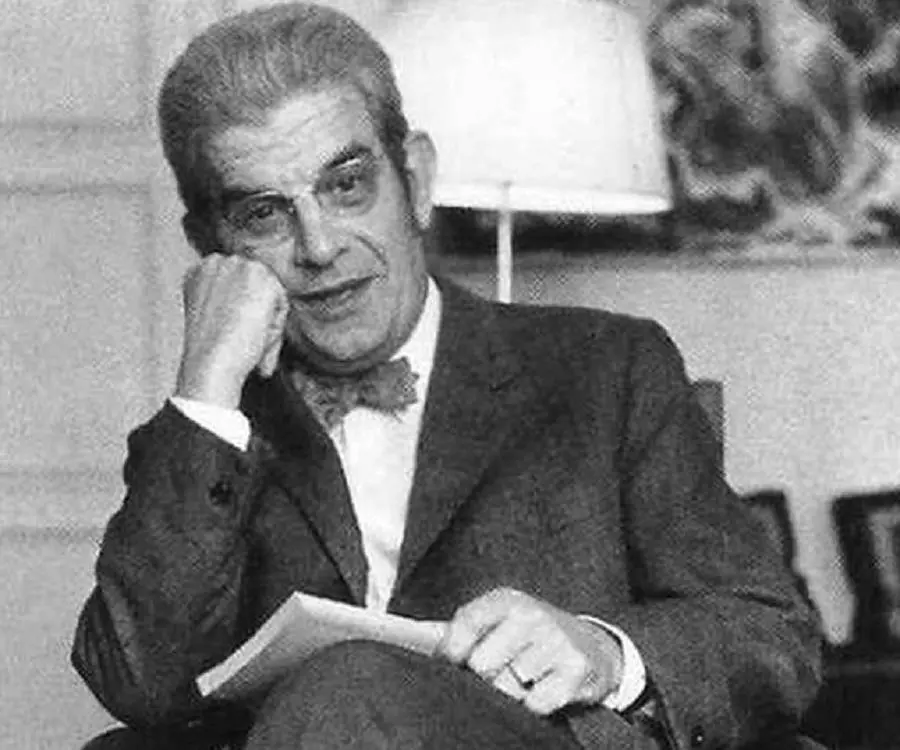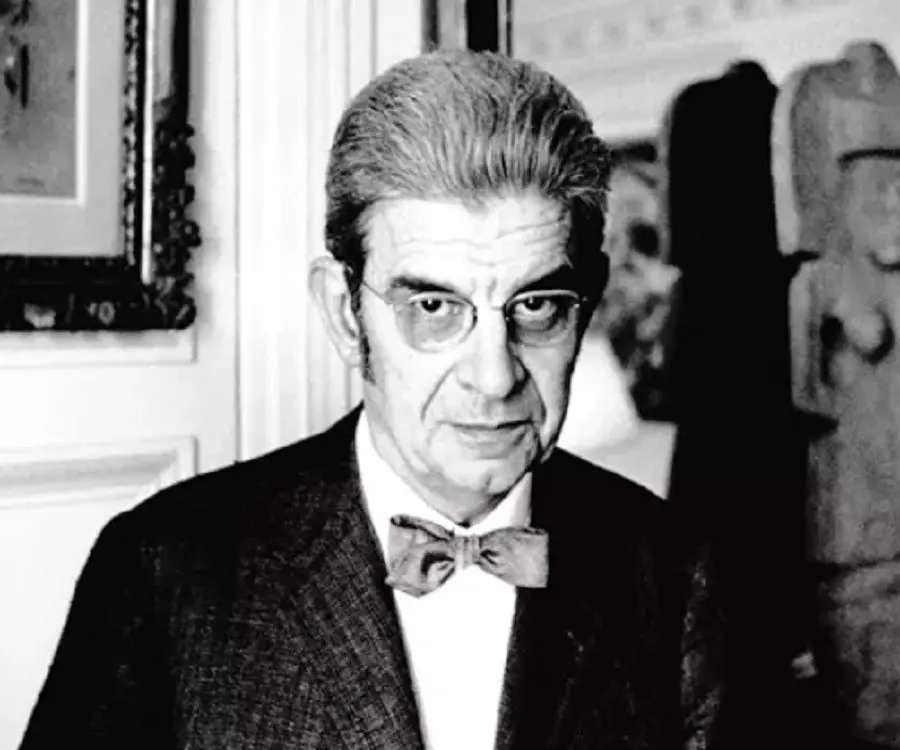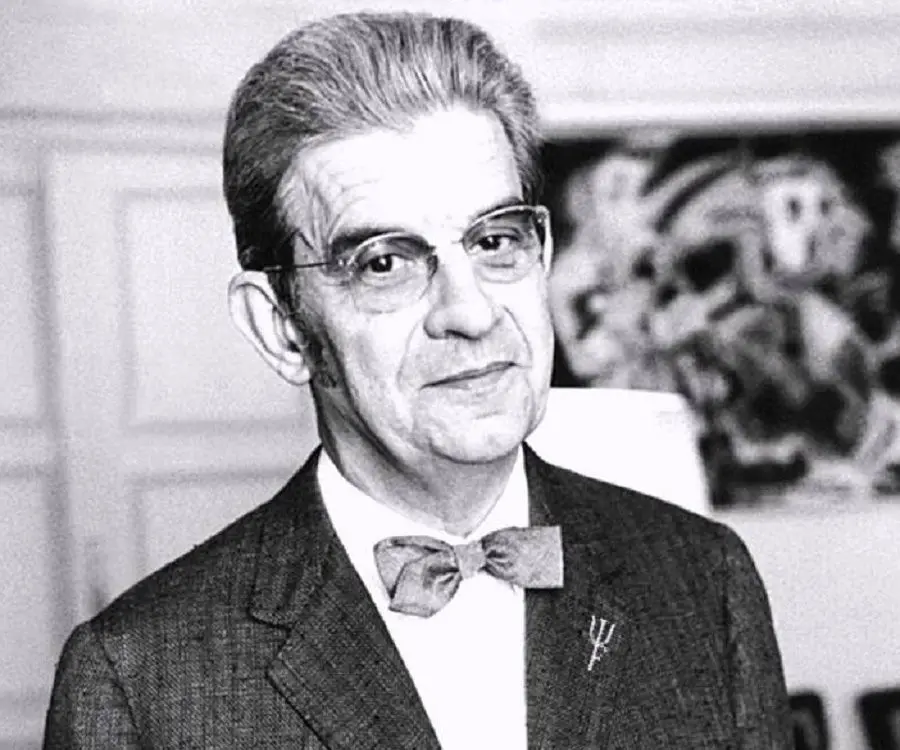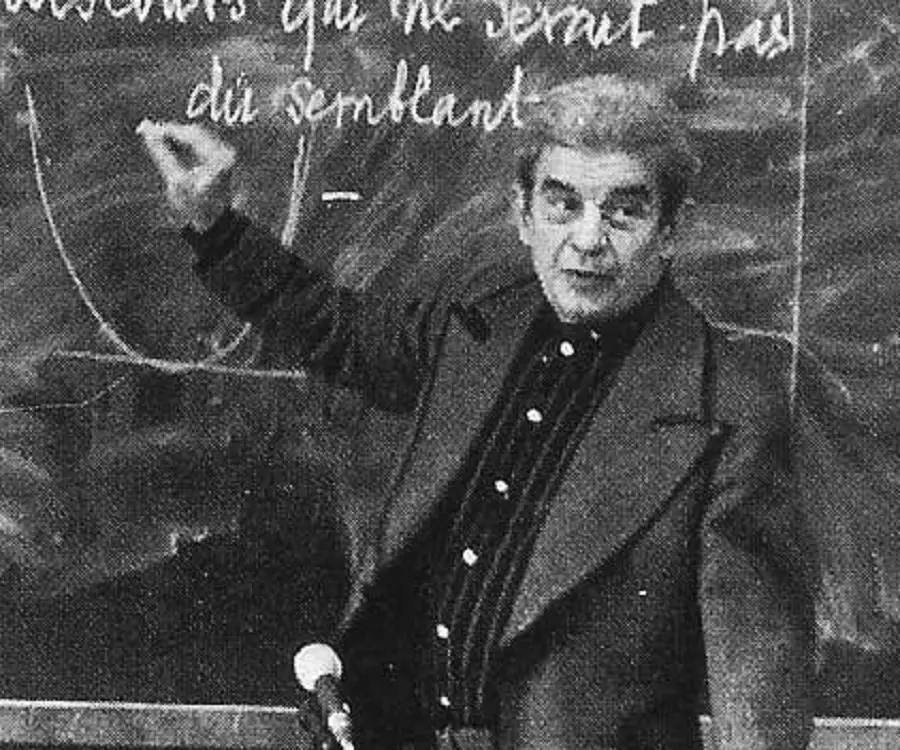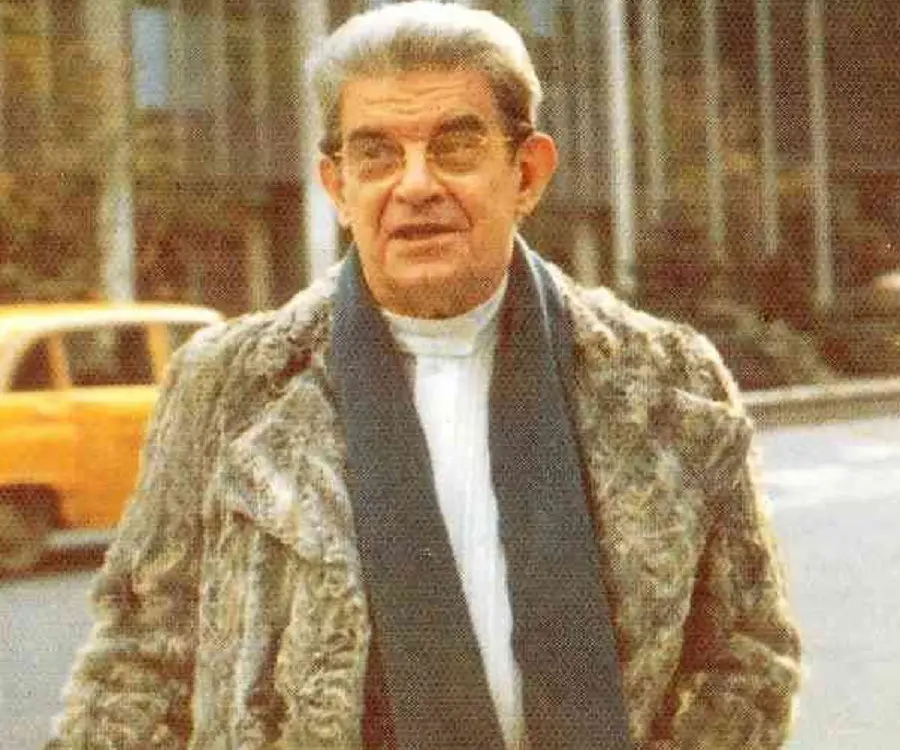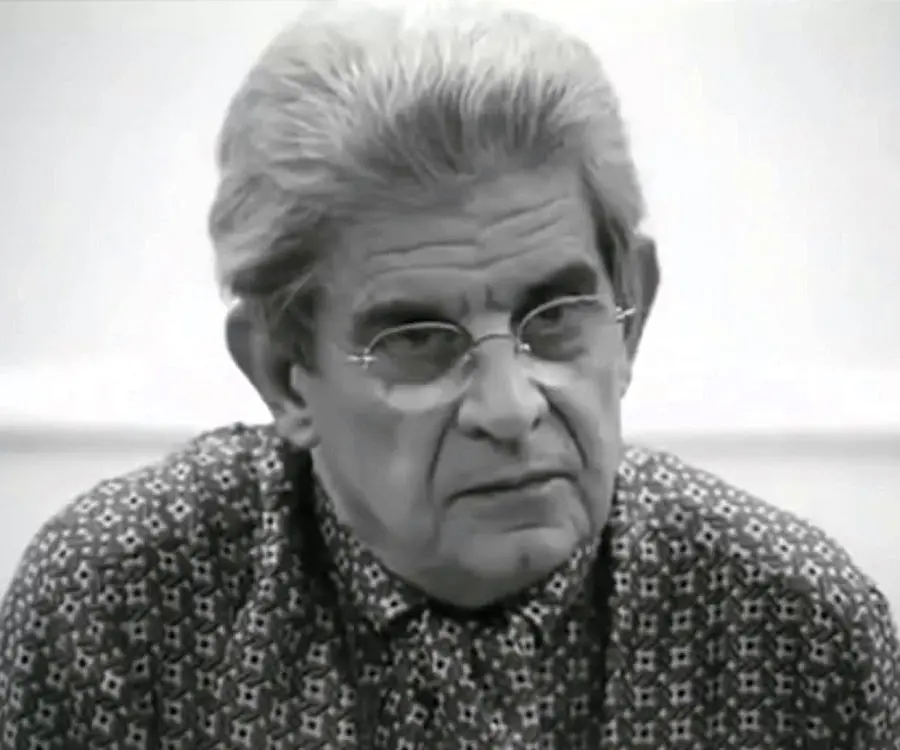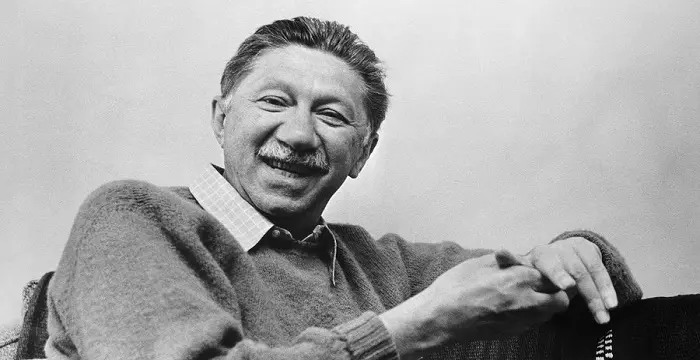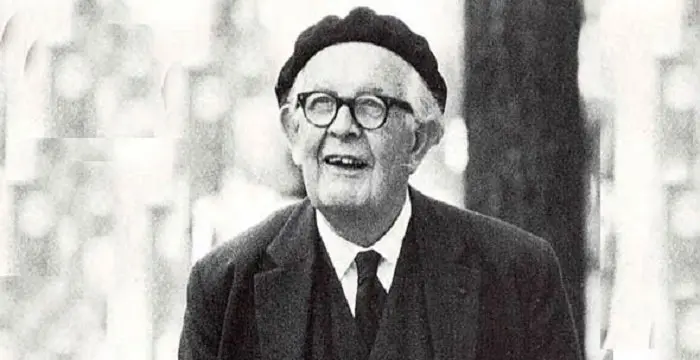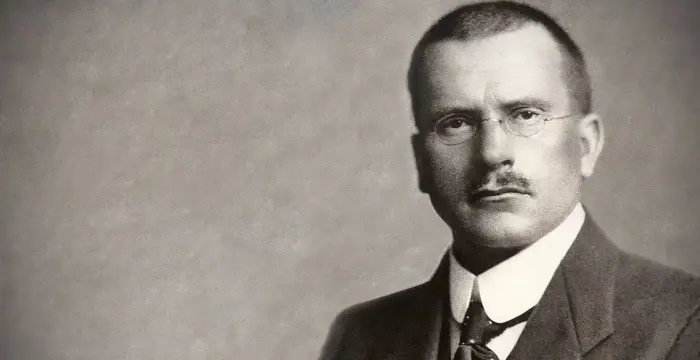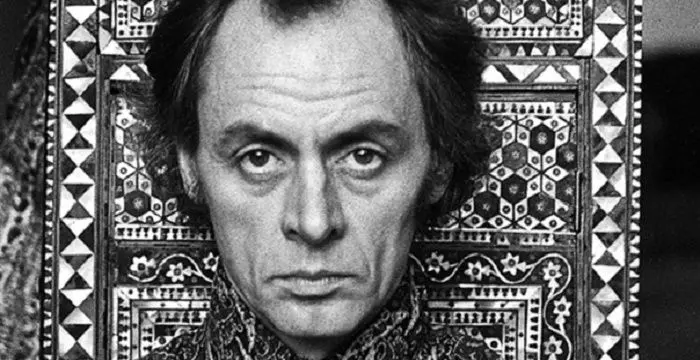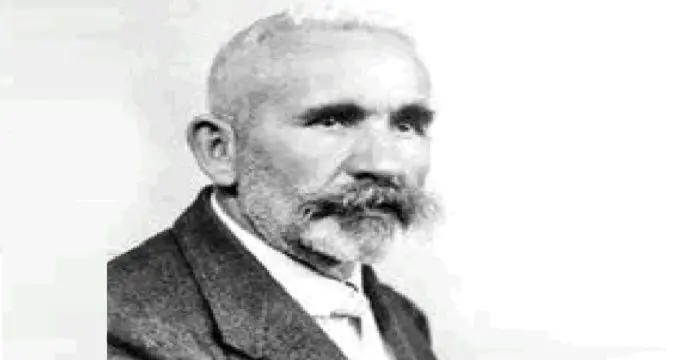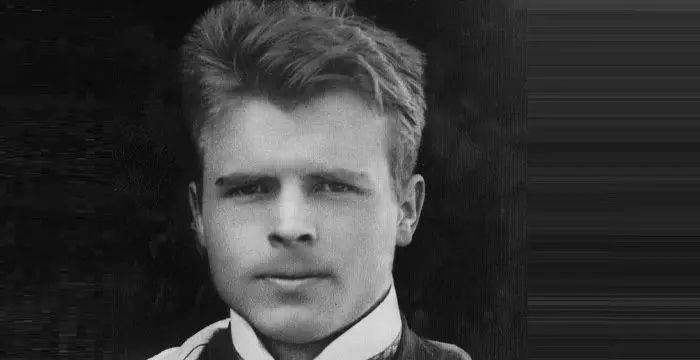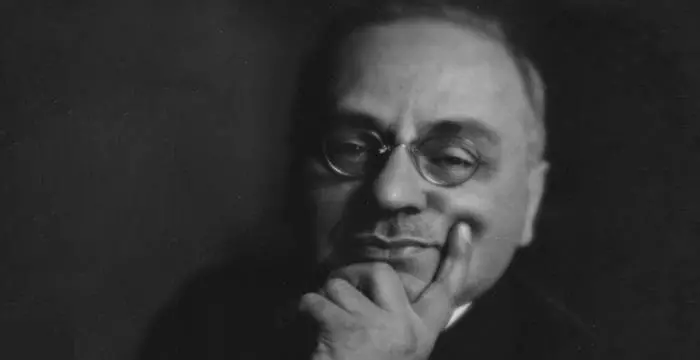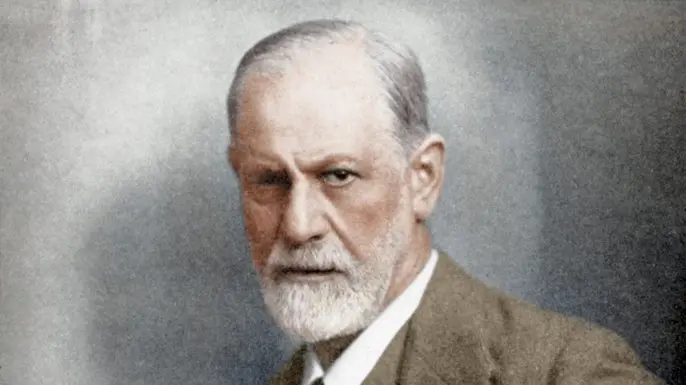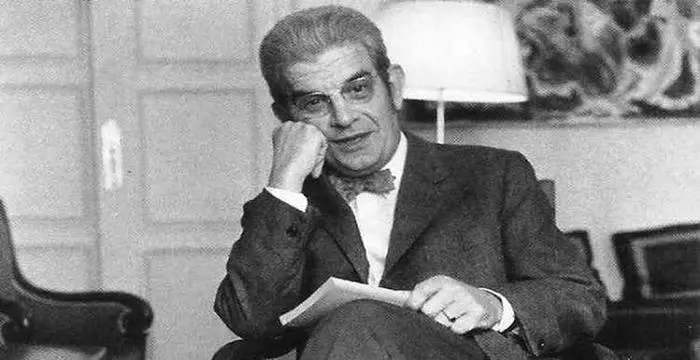
Jacques Lacan - Psychoanalyst, Family and Family
Jacques Lacan's Personal Details
Jacques Lacan was a French psychoanalyst and a psychiatrist, considered to be the most controversial psycho-analyst since Freud
| Information | Detail |
|---|---|
| Birthday | April 13, 1901 |
| Died on | September 9, 1981 |
| Nationality | French |
| Famous | Intellectuals & Academics, Psychologists, Psychiatrists, Psychoanalyst |
| City/State | Paris |
| Spouses | Marie-Louise Blondin (m. 1939–1945), Sylvia Bataille (m. 1953–1981) |
| Known as | Jacques |
| Childrens | Judith, Sibylle, Thibaut |
| Universities |
|
| Founder / Co-Founder |
|
| Birth Place | Paris |
| Gender | Male |
| Father | Alfred Lacan |
| Mother | Emilie Lacan |
| Sun Sign | Aries |
| Born in | Paris |
| Famous as | Psychoanalyst, Psychiatrist |
| Died at Age | 80 |
Jacques Lacan's photo
Who is Jacques Lacan?
Jacques Lacan was a French psychoanalyst and a psychiatrist, considered to be "the most controversial psycho-analyst since Freud". He became interested in the theories of Sigmund Freud in his early thirties, eventually helping to introduce them in France. First recognized for his theory on ‘mirror stage’, which he read at the Sixteenth Congress of International Psychoanalytical Association, he became truly famous when he began to hold private seminars in early 1950s. However, his path was never smooth. His concept of ‘variable-length session’ earned the displeasure of traditional analysts and he had to leave Société psychanalytique de Paris and eventually Société Française de Psychanalyse. Continuing to work, he earned celebrity status at the age of sixty-five with the publication of his lectures and essays in ‘Écrits’. By then, he had established his own school, École Freudienne de Paris. He always put emphasis on the primacy of language and tried to introduce linguistic studies as well as mathematics and logic into psychoanalytic theory. In 1970s, he was one of the dominant cultural figures in France, with his influence spreading beyond the field of psychoanalysis.
// Famous Psychologists
Abraham Maslow
Abraham Maslow was a humanistic psychologist best known for his theory of self-actualization. This biography of Abraham Maslow provides detailed information about his childhood, life, achievements, works & timeline.
Felicitas Rombold
Felicitas Rombold is a German model, academic and the wife of actor Daniel Brühl. Check out this biography to know about her birthday, childhood, family life, achievements and fun facts about her.
Jean Piaget
Jean Piaget was a psychologist and philosopher known for his theory of cognitive development. This biography of Jean Piaget provides detailed information about his childhood, life, achievements, works & timeline.
Childhood & Early years
Jacques Marie Émile Lacan was born 13 April 1901, in Paris into a prosperous middle bourgeoisie family. His father, Alfred Charles Marie Paul Lacan, was ‘representant de commerce’, dealing successfully in soap and oil. His mother, Émilie Philippine Marie Lacan nee Baudry, was an ardent Catholic.
Jacques was possibly born eldest of his parents’ four children, having two brothers named Raymond and Marc-Marie Lacan, and a sister named Magdeleine-Marie Lacan. Later, one of his brothers, Marc-Marie, joined the church and became a priest. Nothing is known about Raymond. They were brought up in strict Catholic tradition.
In 1907, Jacques began his education at Collège Stanislas de Paris, a prestigious Catholic school, run by Jesuit priests and graduated from there in 1918. He was a brilliant and hardworking student, excelling in philosophy and Latin. However, his grades in other subjects were just honorable.
His teacher’s comment in his 1916-1917 report card projects him as rather eccentric and proud. He was also occasionally annoying and never seemed to be able to manage his time. Neither did he behave like other boys, often suffering from listlessness and melancholy.
After completing his baccalauréat, he tried to enter the military service; but was rejected because he was very thin. Possibly in 1920, he entered Faculté de médecine de Paris to study medicine and graduated from there sometime in 1927.
In early 1923, while studying medicine, he first heard about Sigmund Freud's theories. But at that time, he was more interested in right wing politics, attending the meetings of Action Française, also meeting its founder, Charles Maurras. Later, he became disillusioned with the ideology and became highly critical.
In the middle of 1920s, he also became disillusioned with religion, slowly turning into an atheist. Although it made his relationship with his family a little strained he remained faithful to his belief.
In 1927, after graduating from the medical school, he began his residence at the Hôpital Sainte-Anne, specializing in psychiatry under the direction of Gaëtan Gatian de Clérambault. Sometime now, he became immensely interested in the philosophies of Karl Jaspers and Martin Heidegger, also attending seminars on Hegel.
In 1928-1929, he studied at the Infirmerie Speciale pres de la Prefecture de Paris. Thereafter from 1929 to 1931, he served at Hôpital Henry Rousselle, earning his diploma in forensic psychiatry at the end of this period. In 1932, he rejoined Hôpital Sainte-Anne, observing patients, especially one called ‘Aimee’.
Based on these observations at Hôpital Sainte-Anne, he wrote his doctoral thesis. Entitled, ‘De la Psychose paranoïaque dans ses rapports avec la personnalité suivi de Premiers écrits sur la paranoïa’ (On Paranoiac Psychosis in its Relations to the Personality), it earned him Diplôme d'État de docteur en medicine in 1932.
With ‘Paranoiac Psychosis in its Relations to the Personality’, Lacan entered the field of psychoanalysis. It shows that by then, he had become dissatisfied with traditional psychiatry. The influence of Sigmund was also apparent in this work.
Also in 1932, Lacan translated Freud's ‘Some Neurotic Mechanisms in Jealousy, Paranoia and Homosexuality’. Later, it was published as ‘On some neurotic mechanisms in jealousy, paranoia and homosexuality’ in the Revue française de psychanalyse.
Early Career
From the autumn of 1932 to 1938, Lacan worked with Rudolph Lowenstein and received training under him. Meanwhile in 1934, he developed his first version of ‘mirror phase’, presenting it at the Fourteenth Congress of the International Psychoanalytical Association in Marienbad in 1936. However, it failed to have any impact.
Although Lagan did not publish the paper he continued elaborating it. In 1940, he had it published in the form of two essays in Encyclopédie française. But very soon, as Germany occupied France, Société psychanalytique de Paris of which he was a member closed down, halting all academic works.
In 1940, Lacan was called up to serve at the Val-de-Grâce military hospital in Paris, where he remained for the duration of the Second World War, shelving his personal studies. He did not publish any paper until 1945.
In 1948, he was appointed to the Committee of Teaching at the Société psychanalytique de Paris (SPP). In the following year, he wrote SPP’s statues, opening psychoanalysis training to nonmedical students and granting them the rights to practice.
In 1949, he completed a more complex variant of ‘mirror phase’, which he presented at the Sixteenth Congress of International Psychoanalytical Association, held at Zürich. It earned him considerable acclaim.
Acquiring Fame
In 1953, Lacan became famous as he started conducting regular seminars at the University of Paris. In these seminars, held over a period of 27 years, he urged the attendees to return to Freud. Over the time, they began to yield tremendous influence on psychiatric analysis and practice.
Sometime after June 1953, Lacan and his colleagues left Société Parisienne de Psychanalyse over a disagreement concerning Lacan’s ‘variable-length session’, which drastically reduced the fifty-minute analytical hour. Thereafter, he formed Société Française de Psychanalyse (SFP) with four of colleagues, but was deprived from acquiring membership in the International Psychoanalytical Association.
From 1953, he started holding his seminars at Hôpital Sainte-Anne, presenting case histories of patients. Simultaneously, he also started studying Freud's works in relation to contemporary philosophy, linguistics, ethnology, biology, and topology, writing many articles on them.
Over 1950s, Lacan continued to develop his theories, many of which were against the accepted principle. However, to act effectively, he needed to be a member of International Psychoanalytical Association, which was denied to the members of to Société Française de Psychanalyse.
In August 1963, International Psychoanalytical Association sent messages to Société Française de Psychanalyse that they would get the membership only if Lacan’s name was removed from its list of training analysts. SFP accepted the condition and thus Lacan was stripped of his standing.
Deeply wounded, Lacan abandoned his plan of holding a seminar on ‘The Names-of-the-Father’. He also left Hôpital Sainte-Anne and started teaching at the École Pratique des Hautes Études. By 1964, he was back to business, conducting his eleventh seminar, ‘The Four Fundamental Concepts of Psychoanalysis’ at École Normale Supérieure.
Also in 1964, he established his own school, ‘École Freudienne de Paris’. It provided him with the freedom as well as infrastructure to experiment with novel ideas. Thus the rejection by IPA and betrayal by his friends at SFP actually boosted his determination.
In 1966, he published his first important work, ‘Écrits’. Containing many of his important articles, the work, published by Éditions du Seuil, brought him closer to the public. It success led to the publication of two-volume edition in 1969.
Lacan continued with his work throughout 1970s, holding seminars, which were widely followed. During this period, along with developing new concepts, he also continued to work on older ideas such as masculine and feminine jouissance, a French word for enjoyment, further elaborating them.
He had first introduced the concept of jouissance in his Seminar "The Ethics of Psychoanalysis" (1959–1960), differentiating it from ‘pleasure principle’. Later, he had continued to develop it and in the 1972-1973 Seminar, ‘Encore’, he introduced the concept of specifically feminine jouissance, theorizing sexual difference as ‘sexuation’.
In 1974, Lacan was appointed the Scientific Director at the University of Paris VIII. Concurrently, he was the head of the Department of Psychoanalysis at the university. In this latter capacity, he tried to make the study of psychoanalysis more scientific by including logic, mathematics and linguistics in the curriculum.
In early 1970s, he also began working with François Cheng, a Chinese-born French academician, writer and poet, on classical Chinese canon. The work helped him bring in new light to his psychoanalytic interpretation and teaching.
In the last decade of his life, he published number of books. More significant among them are 'The Four Fundamental Concepts of Psychoanalysis' (1973), 'On feminine sexuality: the limits of love and knowledge' (1975) and 'The Ego in Freud's Theory and in the Technique of Psychoanalysis' (1977).
As his fame spread across the world, he began to receive invitation from various countries, visiting Italy, Japan and the United States for lecture tours. But towards the end of 1970s, his health began to fail and in January 1980, he closed down École Freudienne de Paris.
In July 1981, he traveled to Santiago de León de Caracas, the largest city of Venezuela, opening Freudian Field Institute on 12 July and giving his last public address. The institutional document he wrote concerning this new institute was also his last work.
Major Works
Jacques Lacan is best remembered for his 1966 publication, ‘Écrits’. Divided into seven sections, the book deals in seven innovative concepts such as ‘mirror stage’, ‘otherness’, ‘subjectivity’, ‘sexual difference’, ‘the drives’, ‘the law’, and ‘enjoyment’. An instant success, it was later translated into English and German, making him internationally famous.
Awards & Achievements
In 1934, Jacques Lacan was elected to the Société psychanalytique de Paris.
Personal Life & Legacy
In January 1934, Lacan married Marie-Louise Blondin. The couple had three children, Caroline, born in January 1937; Thibaut, born in August 1939 and Sibylle, born in 1940.
Possibly from 1938, while he was still married to Marie-Louise, Lacan became involved with Sylvia Bataille née Maklès, wife of his friend Georges Bataille and an acclaimed actress. They had a daughter named Judith born on 3 July 1941.
After the birth of Judith, Marie-Louise requested divorce, which was granted sometime in 1945. Lacan and Sylvia got married in 1953, remaining together until his death. Judith grew up to be a psychoanalyst and married Jacques-Alain Miller, another Lacanian psychoanalyst and writer.
Jacques Lacan died on 9 September 1981 in Paris, leaving his son-in-law, Jacques-Alain Miller, as his literary executor. Miller later edited ‘Seminars of Jacques Lacan’, which contains the transcripts of Lacan’s seminars from 1952 to 1980.
// Famous Intellectuals & Academics
Bertil Gotthard Ohlin
Bertil Gotthard Ohlin was a famous Swedish economist. This biography profiles his childhood, family life & achievements.
Emily Greene Balch
Emily Greene Balch was an American economist, sociologist and pacifist who won the 1946 Nobel Peace Prize. This biography of Emily Greene Balch provides detailed information about her childhood, life, achievements, works & timeline.
Martin Buber
One of the greatest philosophers to have ever walked on earth, Martin Buber contributions to philosophy is a long-standing one. Explore all about his profile, childhood, life and timeline here.
Jacques Lacan biography timelines
- // 13th Apr 1901Jacques Marie Émile Lacan was born 13 April 1901, in Paris into a prosperous middle bourgeoisie family. His father, Alfred Charles Marie Paul Lacan, was ‘representant de commerce’, dealing successfully in soap and oil. His mother, Émilie Philippine Marie Lacan nee Baudry, was an ardent Catholic.
- // 1907 To 1918In 1907, Jacques began his education at Collège Stanislas de Paris, a prestigious Catholic school, run by Jesuit priests and graduated from there in 1918. He was a brilliant and hardworking student, excelling in philosophy and Latin. However, his grades in other subjects were just honorable.
- // 1916 To 1917His teacher’s comment in his 1916-1917 report card projects him as rather eccentric and proud. He was also occasionally annoying and never seemed to be able to manage his time. Neither did he behave like other boys, often suffering from listlessness and melancholy.
- // 1920 To 1927After completing his baccalauréat, he tried to enter the military service; but was rejected because he was very thin. Possibly in 1920, he entered Faculté de médecine de Paris to study medicine and graduated from there sometime in 1927.
- // 1923In early 1923, while studying medicine, he first heard about Sigmund Freud's theories. But at that time, he was more interested in right wing politics, attending the meetings of Action Française, also meeting its founder, Charles Maurras. Later, he became disillusioned with the ideology and became highly critical.
- // 1927In 1927, after graduating from the medical school, he began his residence at the Hôpital Sainte-Anne, specializing in psychiatry under the direction of Gaëtan Gatian de Clérambault. Sometime now, he became immensely interested in the philosophies of Karl Jaspers and Martin Heidegger, also attending seminars on Hegel.
- // 1932Based on these observations at Hôpital Sainte-Anne, he wrote his doctoral thesis. Entitled, ‘De la Psychose paranoïaque dans ses rapports avec la personnalité suivi de Premiers écrits sur la paranoïa’ (On Paranoiac Psychosis in its Relations to the Personality), it earned him Diplôme d'État de docteur en medicine in 1932.
- // 1932Also in 1932, Lacan translated Freud's ‘Some Neurotic Mechanisms in Jealousy, Paranoia and Homosexuality’. Later, it was published as ‘On some neurotic mechanisms in jealousy, paranoia and homosexuality’ in the Revue française de psychanalyse.
- // 1934In 1934, Jacques Lacan was elected to the Société psychanalytique de Paris.
- // 1938 To 3rd Jul 1941Possibly from 1938, while he was still married to Marie-Louise, Lacan became involved with Sylvia Bataille née Maklès, wife of his friend Georges Bataille and an acclaimed actress. They had a daughter named Judith born on 3 July 1941.
- // 1940Although Lagan did not publish the paper he continued elaborating it. In 1940, he had it published in the form of two essays in Encyclopédie française. But very soon, as Germany occupied France, Société psychanalytique de Paris of which he was a member closed down, halting all academic works.
- // 1940 To 1945In 1940, Lacan was called up to serve at the Val-de-Grâce military hospital in Paris, where he remained for the duration of the Second World War, shelving his personal studies. He did not publish any paper until 1945.
- // 1945 To 1953After the birth of Judith, Marie-Louise requested divorce, which was granted sometime in 1945. Lacan and Sylvia got married in 1953, remaining together until his death. Judith grew up to be a psychoanalyst and married Jacques-Alain Miller, another Lacanian psychoanalyst and writer.
- // 1948In 1948, he was appointed to the Committee of Teaching at the Société psychanalytique de Paris (SPP). In the following year, he wrote SPP’s statues, opening psychoanalysis training to nonmedical students and granting them the rights to practice.
- // 1949In 1949, he completed a more complex variant of ‘mirror phase’, which he presented at the Sixteenth Congress of International Psychoanalytical Association, held at Zürich. It earned him considerable acclaim.
- // 1953In 1953, Lacan became famous as he started conducting regular seminars at the University of Paris. In these seminars, held over a period of 27 years, he urged the attendees to return to Freud. Over the time, they began to yield tremendous influence on psychiatric analysis and practice.
- // 1953From 1953, he started holding his seminars at Hôpital Sainte-Anne, presenting case histories of patients. Simultaneously, he also started studying Freud's works in relation to contemporary philosophy, linguistics, ethnology, biology, and topology, writing many articles on them.
- // Jun 1953Sometime after June 1953, Lacan and his colleagues left Société Parisienne de Psychanalyse over a disagreement concerning Lacan’s ‘variable-length session’, which drastically reduced the fifty-minute analytical hour. Thereafter, he formed Société Française de Psychanalyse (SFP) with four of colleagues, but was deprived from acquiring membership in the International Psychoanalytical Association.
- // Aug 1963In August 1963, International Psychoanalytical Association sent messages to Société Française de Psychanalyse that they would get the membership only if Lacan’s name was removed from its list of training analysts. SFP accepted the condition and thus Lacan was stripped of his standing.
- // 1964Deeply wounded, Lacan abandoned his plan of holding a seminar on ‘The Names-of-the-Father’. He also left Hôpital Sainte-Anne and started teaching at the École Pratique des Hautes Études. By 1964, he was back to business, conducting his eleventh seminar, ‘The Four Fundamental Concepts of Psychoanalysis’ at École Normale Supérieure.
- // 1964Also in 1964, he established his own school, ‘École Freudienne de Paris’. It provided him with the freedom as well as infrastructure to experiment with novel ideas. Thus the rejection by IPA and betrayal by his friends at SFP actually boosted his determination.
- // 1966 To 1969In 1966, he published his first important work, ‘Écrits’. Containing many of his important articles, the work, published by Éditions du Seuil, brought him closer to the public. It success led to the publication of two-volume edition in 1969.
- // 1966Jacques Lacan is best remembered for his 1966 publication, ‘Écrits’. Divided into seven sections, the book deals in seven innovative concepts such as ‘mirror stage’, ‘otherness’, ‘subjectivity’, ‘sexual difference’, ‘the drives’, ‘the law’, and ‘enjoyment’. An instant success, it was later translated into English and German, making him internationally famous.
- // 1974In 1974, Lacan was appointed the Scientific Director at the University of Paris VIII. Concurrently, he was the head of the Department of Psychoanalysis at the university. In this latter capacity, he tried to make the study of psychoanalysis more scientific by including logic, mathematics and linguistics in the curriculum.
- // Jan 1980As his fame spread across the world, he began to receive invitation from various countries, visiting Italy, Japan and the United States for lecture tours. But towards the end of 1970s, his health began to fail and in January 1980, he closed down École Freudienne de Paris.
- // Jul 1981In July 1981, he traveled to Santiago de León de Caracas, the largest city of Venezuela, opening Freudian Field Institute on 12 July and giving his last public address. The institutional document he wrote concerning this new institute was also his last work.
// Famous Psychiatrists
Carl Jung
Carl Jung was a Swiss psychiatrist famous for founding the school of analytical psychology. This biography of Carl Jung provides detailed information about his childhood, life, achievements, works & timeline.
R. D. Laing
R. D. Laing was an eminent Scottish psychiatrist. This biography provides information on his childhood, life, works and timeline.
Emil Kraepelin
Emil Kraepelin was a German psychiatrist who is known as the founder of psychopharmacology and psychiatric genetics. To know more about his childhood, career, profile and timeline read on
Hermann Rorschach
Hermann Rorschach was a Swiss psychiatrist who developed the controversial inkblot test. This biography of Hermann Rorschach provides detailed information about his childhood, life, achievements, works & timeline.
Alfred Adler
Alfred Adler was a physician and psychotherapist famous for founding the school of Individual Psychology. This biography of Alfred Adler provides detailed information about his childhood, life, achievements, works & timeline.
Sigmund Freud
Sigmund Freud was a 19th century neurologist who is hailed as the father of ‘psychoanalysis’. Explore this biography to learn more about his profile, childhood, life and timeline.
Jacques Lacan's FAQ
What is Jacques Lacan birthday?
Jacques Lacan was born at 1901-04-13
When was Jacques Lacan died?
Jacques Lacan was died at 1981-09-09
Where was Jacques Lacan died?
Jacques Lacan was died in Paris
Which age was Jacques Lacan died?
Jacques Lacan was died at age 80
Where is Jacques Lacan's birth place?
Jacques Lacan was born in Paris
What is Jacques Lacan nationalities?
Jacques Lacan's nationalities is French
Who is Jacques Lacan spouses?
Jacques Lacan's spouses is Marie-Louise Blondin (m. 1939–1945), Sylvia Bataille (m. 1953–1981)
Who is Jacques Lacan childrens?
Jacques Lacan's childrens is Judith, Sibylle, Thibaut
What was Jacques Lacan universities?
Jacques Lacan studied at Collège Stanislas (1907–1918), University of Paris (certificate of specialist in legal medicine, 1931. M.D., 1932)
Which company or organization was founded by Jacques Lacan?
Jacques Lacan was the founder/co-founder of École Freudienne de Paris
Who is Jacques Lacan's father?
Jacques Lacan's father is Alfred Lacan
Who is Jacques Lacan's mother?
Jacques Lacan's mother is Emilie Lacan
What is Jacques Lacan's sun sign?
Jacques Lacan is Aries
How famous is Jacques Lacan?
Jacques Lacan is famouse as Psychoanalyst, Psychiatrist
